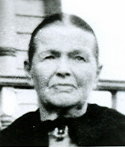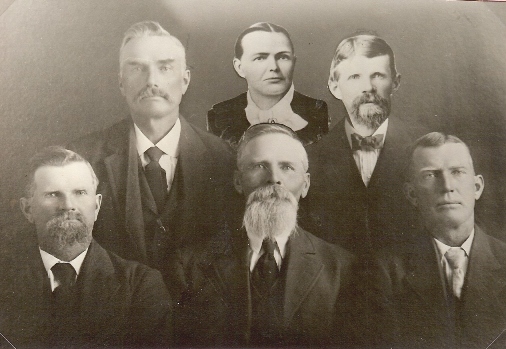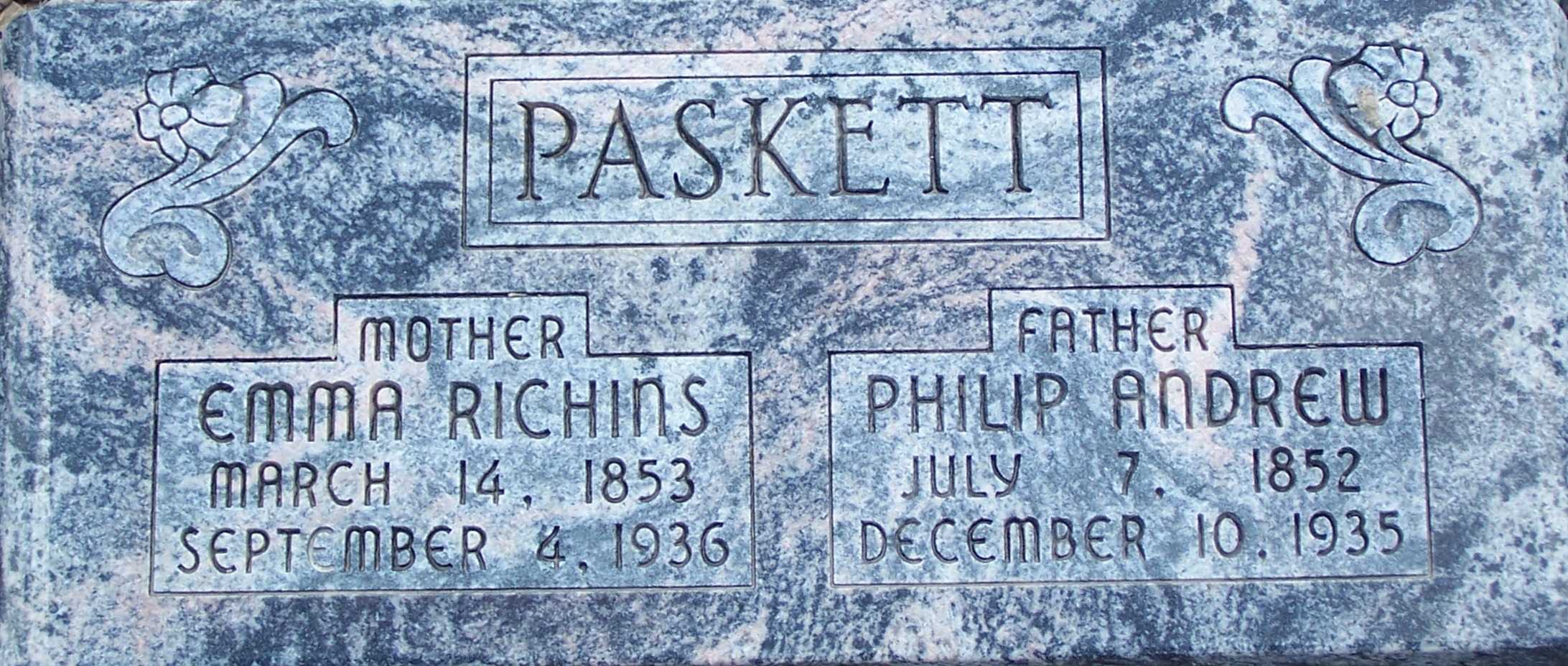
 Emma Richins, daughter of Joseph Richins and Jane Morse, was born on March 14, 1853 at Sheepscombe, Glousestershire, England. She was the third of six children and the only girl. Her older brothers were George Henry, born on June 9, 1848 and Lorenzo, born on August 22, 1851. The younger brothers were Albert Francis, born on May 3, 1855, William, born on July 4, 1860 and Arthur Joseph, born on July 29, 1867. All of the children were born at Sheepscomb, England.
Emma Richins, daughter of Joseph Richins and Jane Morse, was born on March 14, 1853 at Sheepscombe, Glousestershire, England. She was the third of six children and the only girl. Her older brothers were George Henry, born on June 9, 1848 and Lorenzo, born on August 22, 1851. The younger brothers were Albert Francis, born on May 3, 1855, William, born on July 4, 1860 and Arthur Joseph, born on July 29, 1867. All of the children were born at Sheepscomb, England.
Joseph, her father, was also born in Sheepscomb on August 16, 1826. He married Jane Morse on March 5, 1848. She was born on August 14, 1824 in Sheepscomb. They first heard the gospel from Elder Charles Shill and Elder Charles Blackwell. Joseph was baptized on January 1, 1850 and Jane on February 3, 1850. Emma was baptized on October 8, 1864 at Sheepscomb. England. She attended the public school there for a short time and learned to read and write well, but had to stop school and help earn the living. She went to Wales and went into “service” doing housework, mostly cleaning. It was the custom there to be very strict and the servant class had to eat at another table. A picture was taken of Emma at this time, holding the baby of her employer on her lap.

Albert Francis Richins. William Richins, Lorenzo Richins, Emma Richins Paskett, George Henry Richins & Arthur Joseph Richins
When her oldest brother, George, came to America, she walked fourteen miles in the rain to see him off. This caused her to become ill and she developed varicose veins, which bothered her a great deal the rest of her life.
Her hair was heavy and so long she could sit on it. It was a rich brown color much the same as her daughter, Annie’s. Even at the age of eighty-three, she had but few gray hairs. Her eyes were a dark blue and her complexion was fair with no freckles or blemishes to mar it.
Emma, her parents and three brothers set sail from Liverpool on September 4, 1872, on the ship “Minnesota.” Lorenzo had left for America six months earlier. They arrived in Salt Lake City on the 26th of the same month, that being 22 days for the trip. At this time the railroad spanned the plains. Emma was nineteen years old when she came to America and the following year she married Philip Andrew Paskett. He had come from Tetbury, England in 1871, the year before she did. He was on born July 7, 1852, and was the son of James Pope and Charlotte Buckingham Paskett. They were married on June 16, 1873 in the old Endowment House by Daniel H. Wells. They went to Salt Lake in a wagon by way of Silver Creek and through Parley’s Park.
Henefer was their chosen home as both of their parents lived there. William C. Betteridge had furnished a team and wagon the year before and had helped cut the logs and build a large one-room log cabin for the young couple. John Paskett, Philip’s brother, had given him two city lots on which they built the cabin. It was here that their first two daughters were born, Emily Emma on May 7, 1875, and Charlotte (Lottie) on August 20, 1876. Philip taught school the first two years of their married life.
There was mention of the region of Grouse Creek, and several men from Henefer became interested and decided to go out and have a look at the new country. Philip was one of the group that drove out by the way of Kelton. It took one week to drive out. This was in 1877. They found the Etna side had been taken up as the natural meadows attracted the first settlers. They went to the East Fork or Grouse Creek and found plenty of firewood, posts for corrals, logs for homes and grass for their livestock so they decided to settle. They staked off land, hauled out a set of logs and built a 16 x 20-foot room and made a corral of cedar posts, then they went back to Henefer to get their families.
The group from Henefer reached Grouse Creek in October 1877 and lived in their covered wagons the first winter. They had brought milk cows and plenty of provisions and were pretty well off the first winter in spite of the living conditions. Others that came at the same time were William Paskett and Albert F. Richins.
Their first son was born in a dugout house south of William Paskett’s on December 9, 1878, and was named Philip James. When the rock house south of George Blanthorn’s was finished, they moved into it just in time for Annie to be born on February 6, 1881. Jim Simpson was the stone mason for this house. Eventually they had twelve children, six boys and six girls. Besides the four previously mentioned children, there was Pollie, born on March 21, 1883, at Grouse Creek; Frank, born on January 25, 1885; Parley Richins Paskett, born on April 2, 1887; Joseph, born on September 5, 1889 (died on January 7, 1890), Rosabel, born on December 22, 1890; Sidney, born on December 6, 1892 at Huntington, Utah; George, born on December 29, 1893 at Basalt, Idaho, and the last, a daughter, Christine, born on May 27, 1895 at Grouse Creek.
Emma exchanged services as midwife with Ellen Simpson. She helped deliver most of Albert (a brother) and Jane’s children, also those of Ellen Simpson, Sarah Kimber and Emily Tanner, for whom she delivered a set of twin boys. Her last cases were the older children of Elaine Frost. She helped her daughter, Emily with those deliveries. Elaine was the daughter of Emily. At one time Emma was called as midwife to deliver a baby on one of the Nevada ranches near Montello. She didn’t charge anything for her services but the grateful family gave her a piece of beautiful brown alpaca to make a dress. It looked like silk.
Philip became afflicted with rheumatism and they decided to try a warmer climate. So they sold out, taking their pay in horses and left forHuntington, Utah, in the fall of 1891. Charles Kimber Jr. was with them and together they had 90 head of horses that had to be pastured and night herded. They crossed the salt flats to Tooele and on to Huntington. That winter was spent in Huntington, then plans were changed and the Paskett family set out for Idaho. Near Basalt, they settled and had some hard times. They did not stay long in Idaho as Philip became bedfast. Relatives helped to move him and his family back to Grouse Creek. Soon afterwards, he received a blessing of health and was soon working on providing a home and living for his family.
Emma had her last three children after she was forty years of age. They were born a year apart so all were in diapers at the same time. She had a lot of hardship and poverty in her life, but she was even-tempered and never did grumble no matter what. Her husband, Philip, had a quick temper and sometimes when he had laid down the law, she would say firmly, “No, that I shan’t.” She was a very patient woman but stood up for her own rights.
When deaths occurred within her family at Henefer, she would go on a wagon to Terrace and board the Southern Pacific train to Echo and attend the funeral. Her mother, Jane Morse, died on November 23, 1885, at the age of sixty-one. Her father, Joseph Richins, died on March 14, 1898, at Henefer.
With the help of his oldest son, Philip James, Philip was able to build a five-room frame house, which they moved into on December 23, 1910, two days before Christmas.
Emma provided food and beds for the visiting church authorities as her husband was in the bishopric serving as counselor to Bishop Charles Kimber Sr., who lived on a ranch about twelve miles from the church house. The Bishop would often eat with them also. He didn’t believe in cooking or dirtying dishes on Sunday so he would have a piece of bread and butter and be satisfied.
When Apostle Richards came out to dedicate the meeting house, he stayed with Philip and Emma. They also had in their home at different times, Apostle Lorenzo Snow and his wife, Minnie, Rudger Clawson, President of the Box Elder Stake, Oliver G. Snow and others. Minnie Snow was the President of the Primary at that time. The visiting authorities would always drive out by team.
Emma was staunch in her religious convictions and walked uprightly and taught her children to do the same. She taught honesty and self-control by example. She had a gift for poetry and wrote verses. Her daughter, Polly, has one of the poems she wrote. She had a good soprano voice and sang in the ward choir. Someone said that if Emma was present the practice would be a success, as she would lead out. She had a strong English accent. She would say “me” for “my”. Her hobbies were singing, needlework and knitting. Her husband said their children were never ragged but were often patched. She was a good dressmaker and would sometimes make a coat or vest for her husband. She knit long black stockings for her children. Annie recalls how she hated those scratchy woolen stockings. As to keeping house, it was told by some of her neighbors that she was such a good housekeeper that it would be possible to eat off the floor, it was so clean.
Cooking was one of her talents, especially English boiled apple dumplings, plum pudding and sauce, mincemeat, yeast bread made with her own yeast and head cheese. Also a long list of other goodies too long to mention. The apple dumplings were pared, cored and quartered apples with cloves and sugar, wrapped up in pie crust made with small chunks of suet. Each dumpling was wrapped separately in a cloth and boiled in salted water. These were eaten with cream. They were delicious. The plum pudding was made with suet and soggy just as all English people love them. The dip or sauce sometimes had some brandy in it. One Christmas Annie Barlow took some of her own pudding sauce over to her parents. She asked later how they like it. Emma replied, “Yes, it was good, but I like me own the best.”
Emma lived to the age of eighty-three. She lived with her husband sixty-two years. In her last years she was more or less a invalid and went out very little. When she and her husband with both ill, they would lie in bed and sing together, he having a very good tenor voice. They would sing hymns, always hopeful and true to the faith.
After her husband passed away, her children took turns staying with her, and sometimes she would wake them up in the middle of the night to sing anthems and hymns to them even though it was hard for her to get her breath. She would also recite poetry she had learned when she was a young child.
She passed away on September 4, 1936, at her home in Grouse Creek. The funeral was held on the 7th in the Grouse Creek Ward chapel and she was buried beside her husband, who had died on December 10, 1935, to be united again after only nine months apart.

